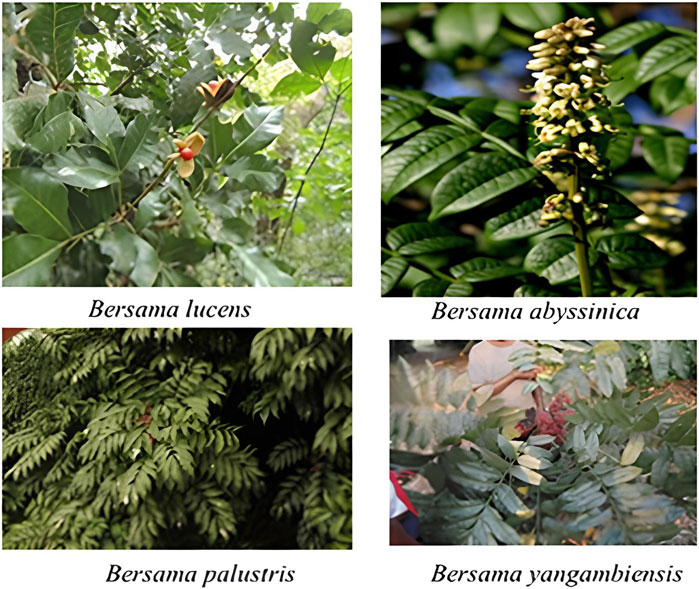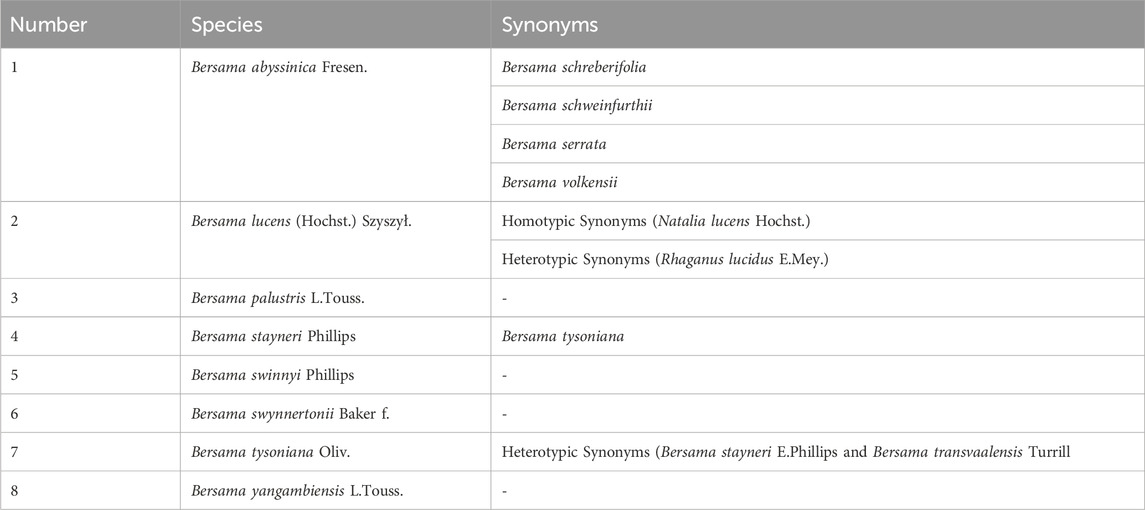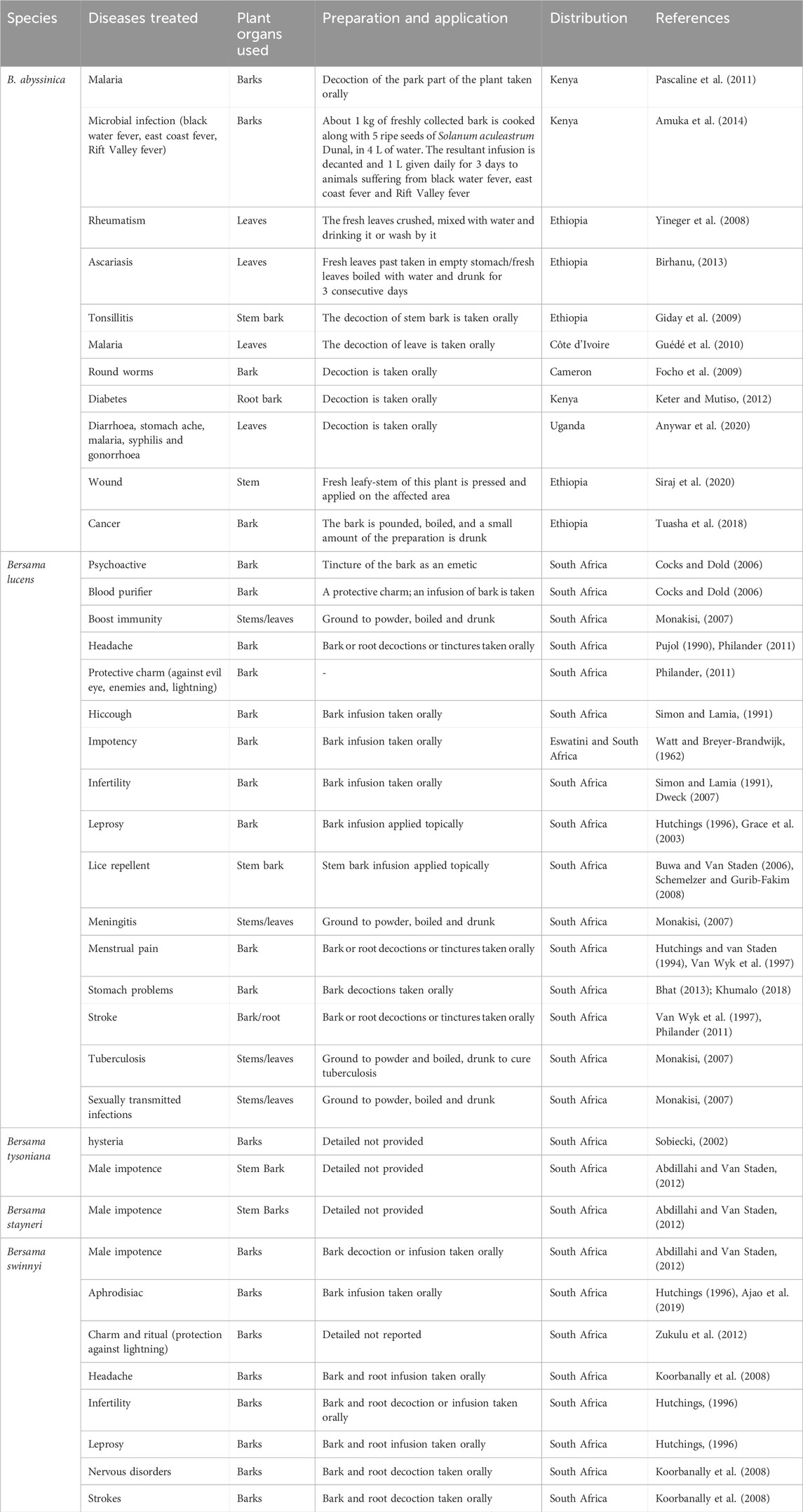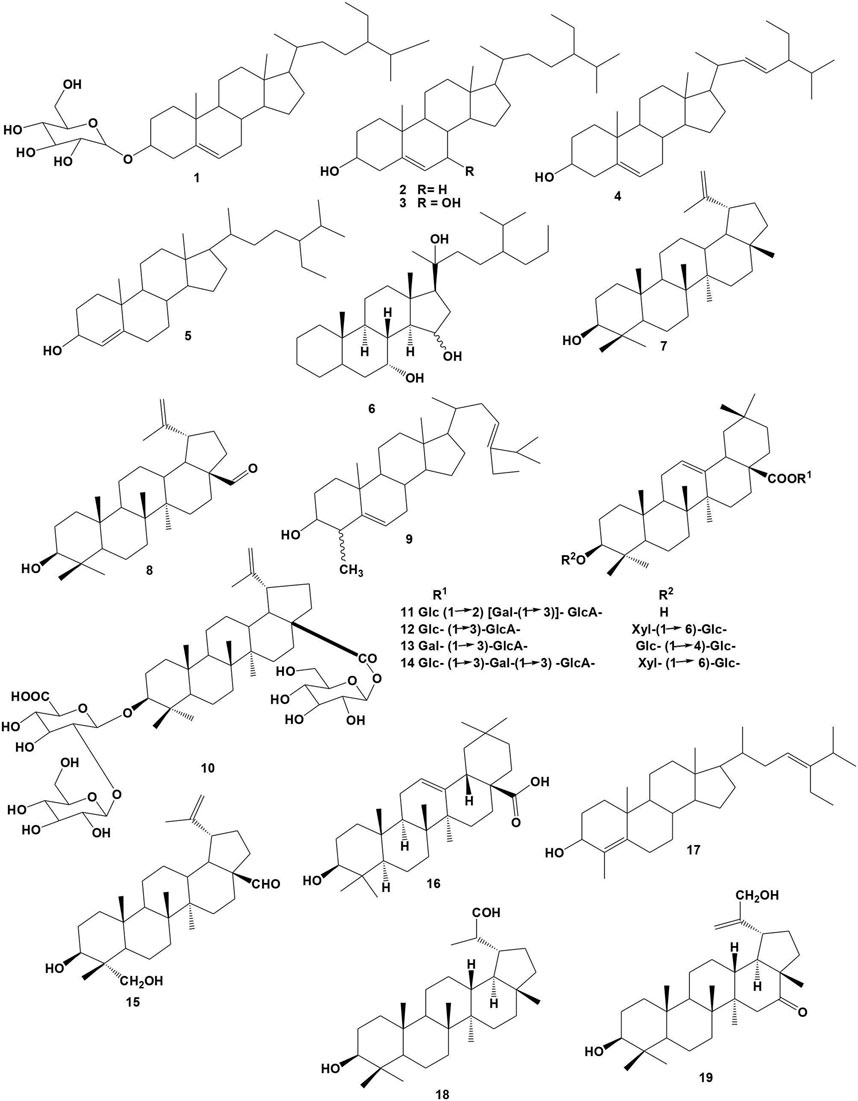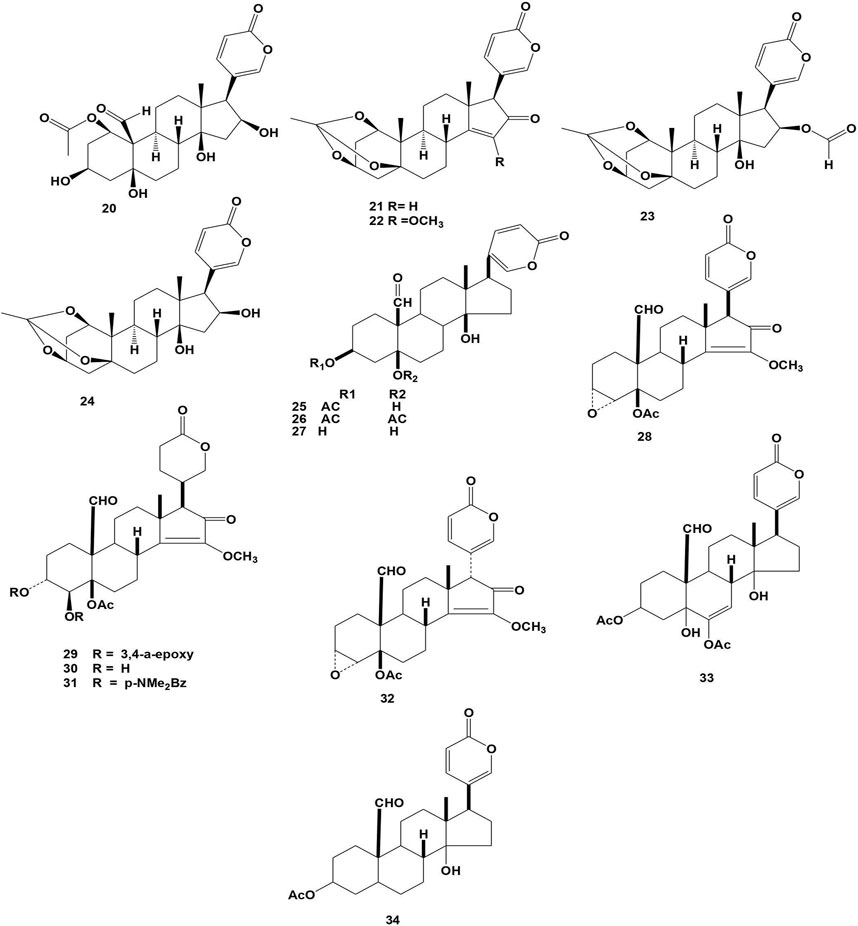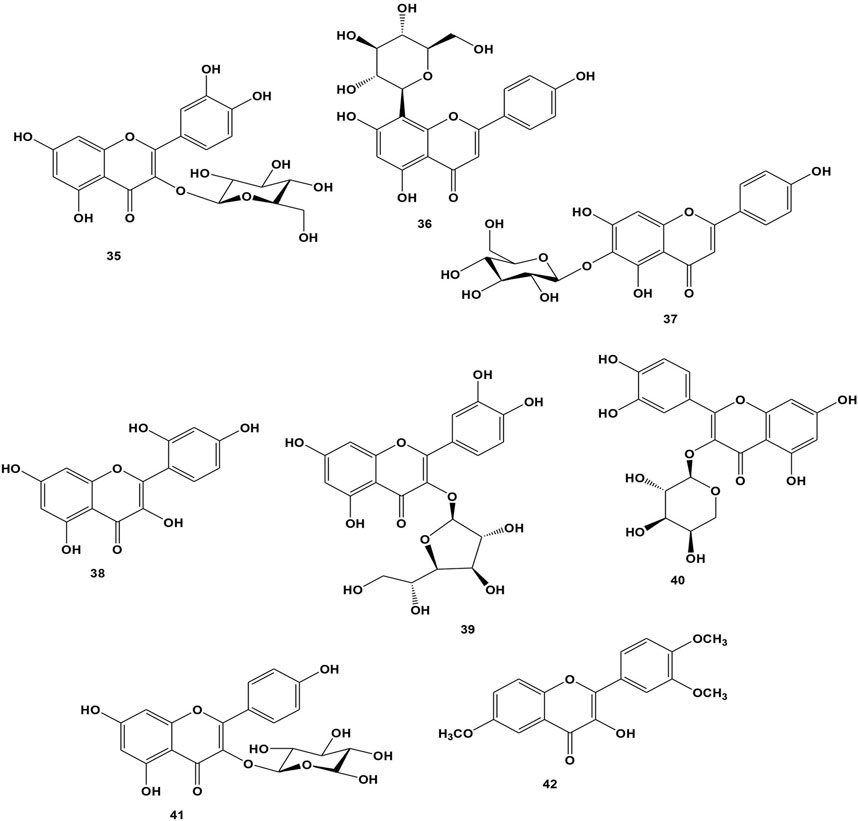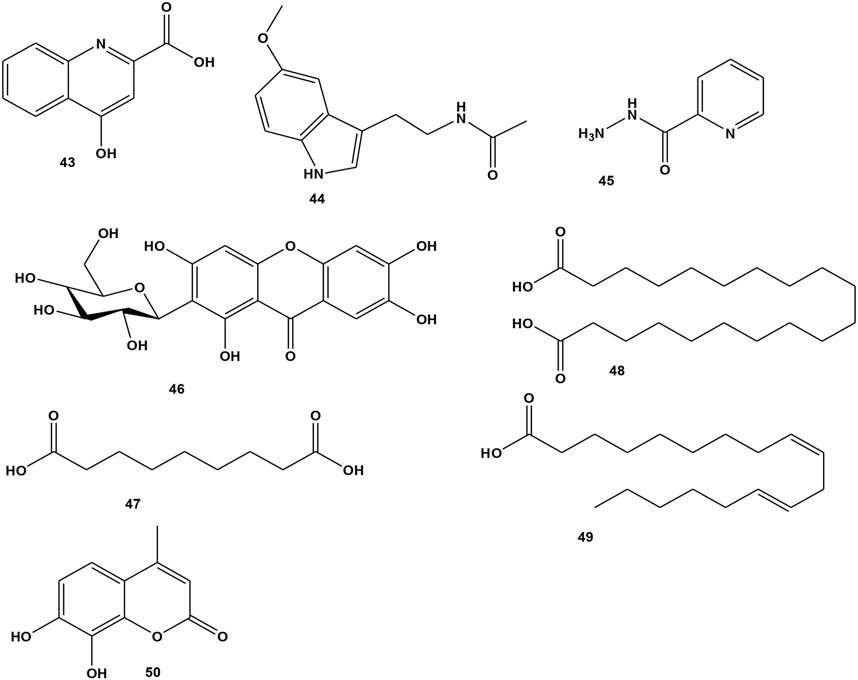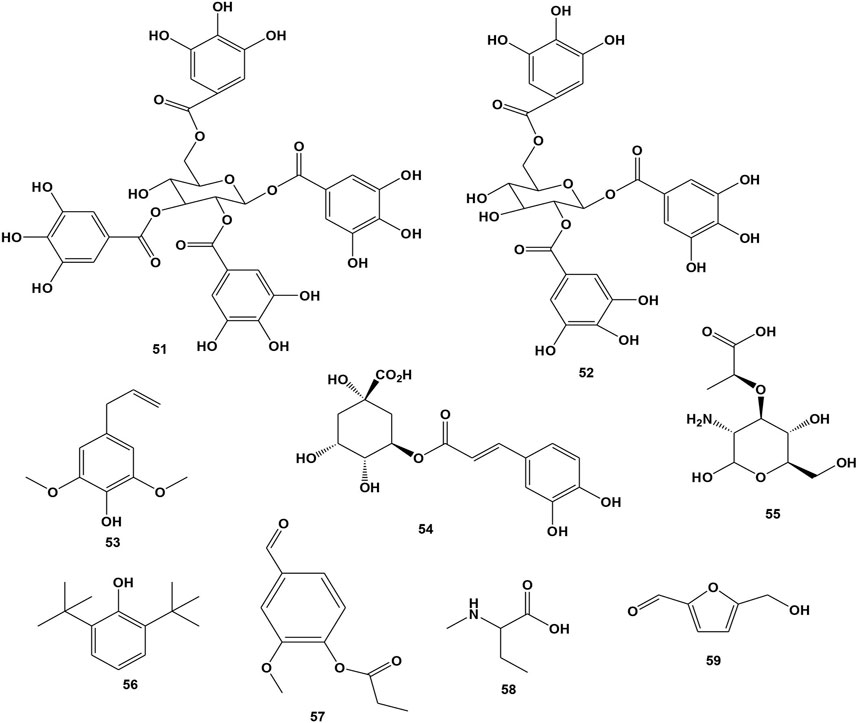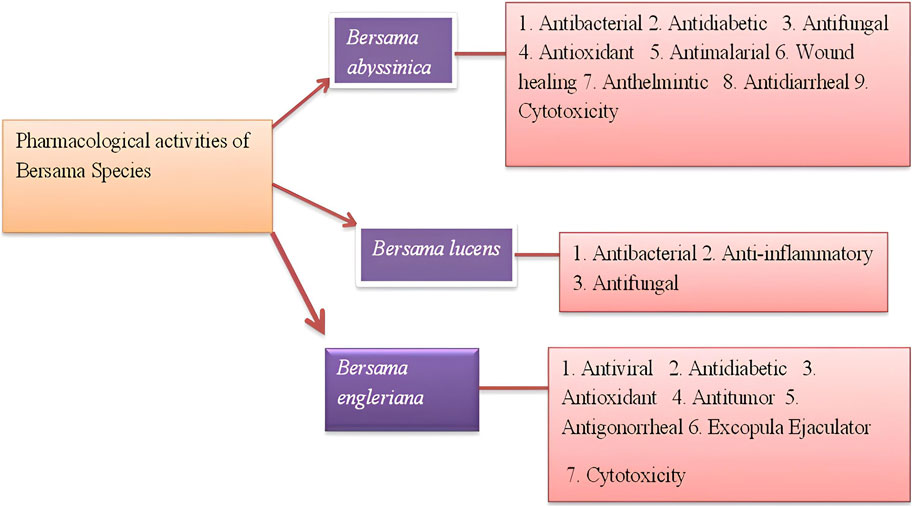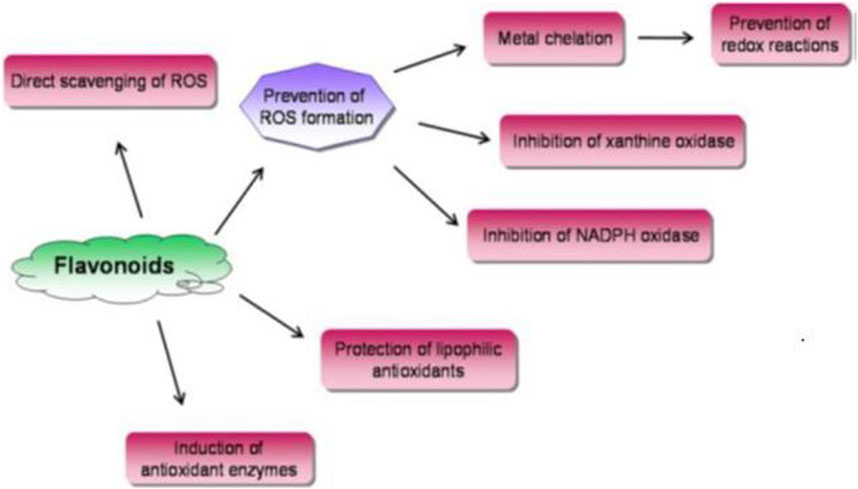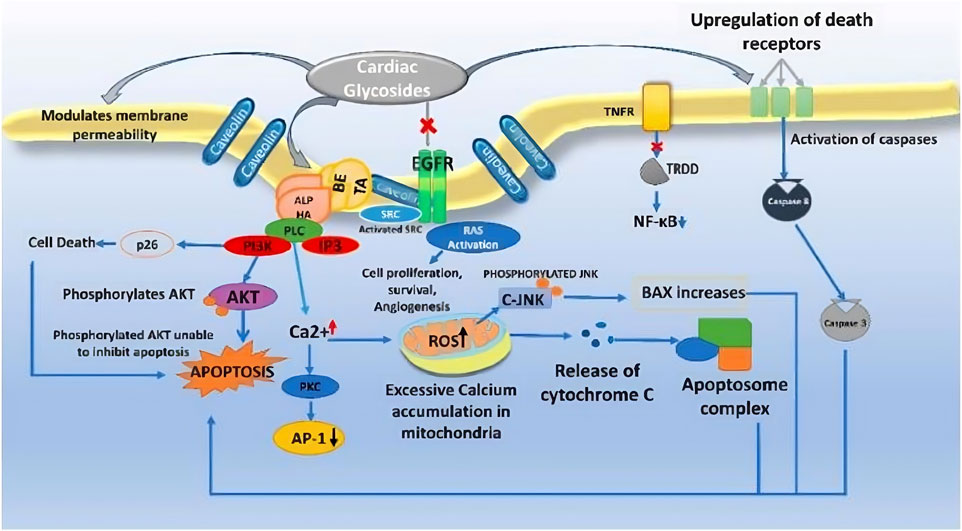- Traditional and Modern Medicine Research and Development Directorate, Armauer Hansen Research Institute, Addis Ababa, Ethiopia
Bersama (Melianthaceae) has been used in traditional medicine for a wide range of ailments, including blood purifier, immune booster, psychotropic medication, and treatment for malaria, hepatitis, infertility, diabetes, impotency, meningitis, and stroke. This review gathers fragmented information from the literature on ethnomedicinal applications, phytochemistry, pharmacology, and toxicology of the Bersama genus. It also explores the therapeutic potential of the Bersama genus in ethnophytopharmacology, allowing for further investigation. All the available information published in the English language on Bersama genus was compiled from electronic databases such as Academic Journals, Ethnobotany, Google Scholar, PubMed, Science Direct, Web of Science, and library search using the following keywords: “Bersama genus,” “traditional use,” “phytochemistry,” “pharmacological effects,” and “toxicology”. The ethnomedical applications of the Bersama genus have been recorded, and it has been used traditionally for more than 30 different types of ailments. Thus far, more than 50 compounds have been isolated from the genus. Cardiac glycosides and terpenoids are the main compounds isolated from the Bersama genus. Different plant parts of Bersama genus extracts demonstrated a wide range of pharmacological properties, including antioxidant, antimalarial, antidiabetic, antiviral, anti-inflammatory, and cytotoxic activity. Exemplary drug leads from the genus include mangiferin and quercetin-3-O-arabinopyranoside, both of which have antioxidant activities. Bersama genus has long been used to cure a wide range of ailments. Bersama genus extracts and phytochemicals have been found to have promising pharmacological activities. Further study on promising crude extracts and compounds is required to develop innovative therapeutic candidates.
1 Introduction
Medical plants are essential parts of medicine and have a significant role in local healthcare systems, especially for rural people (Tola et al., 2023). Ethnic cultures are closely associated with plant knowledge and use. Geographical location, climatic conditions, and quantity of medicinal plants all influence their distribution, taxonomic variety, and abundance, and different communities have different ethnomedicinal treatment systems (Farooq et al., 2019). Approximately more than 80% of the world’s population employs traditional and complementary medicine (WHO, 2013). The report shows that medicinal plants are being researched as a complementary therapy and as a support for medical treatments. Before the advent of modern medicine, indigenous knowledge that was passed down through generations contained health-related elements that are now included in traditional medicine. Traditional medicine is described by the WHO as an array of abilities, knowledge, and practices based on theories, beliefs, and indigenous wisdom of various cultures for the prevention, diagnosis, improvement, and treatment of mental and physical disorders (WHO, 2013). Traditional medicine, which primarily uses plants, has frequently been supported by phytochemical investigations, pharmacological studies, and clinical trials, sparking further study on medicinal plants in various parts of the world (Nigussie et al., 2022). To assure the effectiveness and safety of traditional medicine and the practices used by practitioners and patients of traditional medicine, a more in-depth investigation is required. Traditional medications, on the other hand, have the potential to have negative side effects. In order to support member nations in strengthening the role of traditional medicine in maintaining public health, WHO developed strategy plan (WHO, 2013). Most member nations are currently implementing this strategic plan (WHO, 2013).
Bersama is a genus of eight species that are found throughout tropical and subtropical Africa (Acharyulu et al., 2014). It consists of trees and shrubs from the Melianthaceae family. Bersama abyssinica Fresen., Bersama lucens (Hochst.) Szyszył., Bersama palustris L. Touss., Bersama stayneri Phillips, Bersama swinnyi Phillips, Bersama swynnertonii Baker f., Bersama tysoniana Oliv., and Bersama yangambiensis L. Touss. are among the recognized species. Bersama is the Ethiopian name for this genus (Verdcourt, 1957; Baijnath, 2021). This genus includes evergreen shrubs to small trees up to 12 m tall with grey or brown bark that are found in the Democratic Republic of the Congo, Tanzania, Mozambique, Zambia, Zimbabwe, Angola, Nigeria, Ethiopia, Kenya, Sudan, and Uganda (Djemgou et al., 2010). It grows from sea level up to 2,700 m altitude in lowland bush savanna and gallery forests. The genus is employed by local communities to treat microbiological illnesses, especially mycobacterial infections (Geyid et al., 2005). Bersama genus have been used extensively and routinely by society and traditional healers for a variety of ailments. The leaves, stems, and roots are utilized in the preparation of traditional medicine. Bersama genus exhibited an extensive range of biological activities and chemical compounds (Amit et al., 2010). According to the World Health Organization’s traditional medicine report, traditional medicine and complementary products, practices, and practitioners will continue to be in high demand (WHO, 2013). However, there is a lack of knowledge documentation. Since no comprehensive review study on the diverse aspects of the genus Bersama has been published to date, this review focuses on ethnomedicinal use, phytochemistry, and pharmacological activities. The representative samples of Bersama genus are presented in Figure 1 (Mbuvi et al., 2019; Agidew, 2022).
2 Review methodology
For this review, a comprehensive literature search was conducted up to 28 February 2023, traditional use, phytochemical constituents, pharmacology, toxicological studies of Bersama genus. GN and AM retrieved all of the information that was available on Bersama genus from library documents and online databases (PubMed, Web of Science, Wiley, Science Direct, Elsevier, Scopus, Frontiers, ACS publications, SciFinder, and Google Scholar). The keywords used to search were: “Bersama genus,” “traditional use,” “phytochemistry,” “pharmacological effects,” and “toxicology”. Most of the cited information in this review were taken from peer-reviewed journals and were published in English. Information of related books, PhD and MSc dissertations were also used as references. After retrieving articles, books, and Ph.D. and MSc dissertations, AM and SA carefully collected data about the pharmacological properties, phytochemistry, and ethnomedical uses of Bersama genus. Reviews with unclear validity, papers in languages other than English, papers that did not have significant findings were excluded, while studies with high relevance were critically appraised. The worldwide plant name index (https://www.ipni.org) and the Kew Botanical Garden plant name database (https://www.kew.org) were used to validate species names and their synonyms are presented in Table 1.
3 Result and discussion
3.1 Ethnomedicinal uses
The genus is well known for its therapeutic properties. Decoctions of B. lucens bark have been widely used in traditional South African medicine to treat various ailments, including for mental disorders, purify blood, headache, impotency, leprosy, meningitis, sexually transmitted infections, and tuberculosis (Watt and Breyer-Brandwijk, 1962; Cocks and Dold, 2006; Monakisi, 2007; Bhat, 2013). B. swinnyi and B. tysoniana also recognized as important sources of traditional treatments for migraines, impotence, infertility, menstrual discomfort, mental disorders, strokes, and venereal illnesses (Hutchings, 1996). These three species are included in the book “medicinal plants of South Africa,” a monographic guide to the most widely used medicinal plants in the nation, including their taxonomy, botanical description, primary medicinal uses, preparation and dosage, active phytochemical compounds, and pharmacological effects (Van Wyk et al., 1997). This inclusion is based on the plants’ popularity as medicines. Additionally, in around two-thirds of South Africa’s provinces—the Eastern Cape, Gauteng, KwaZulu-Natal, Mpumalanga, Northern Cape, and Western Cape provinces—the bark and roots of B. lucens are sold as herbal remedies in informal herbal medicine markets (Cocks and Dold, 2006). Traditional medicine has made considerable use of the bark, leaves, and roots of B. abyssinica to make decoctions that can be used to treat a variety of issues, including colic, diarrhea, dysentery, and intestinal worms. Additionally, B. abyssinica is used to treat rheumatoid arthritis, cancer, diabetes, lumbago, gonorrhea, syphilis, malaria, diabetes, debility, hemorrhoids, and epilepsy (Zekeya et al., 2014). Beer is flavored with powdered B. abyssinica stem bark or leaves as an aphrodisiac (Sinan et al., 2021). Leprosy, menstrual cramps, barrenness, and impotence were all treated with a decoction of the leaves and roots (Nakamura et al., 2017). In southern Ethiopia, liver ailments and snake bites were treated using the stem bark of B. abyssinica (Kidane et al., 2014). In Kenya, 1 kg of freshly collected B. abyssinica bark is boiled in 4 L of water with 5 ripe Solanum aculeastrum Dunal seeds, and the resulting infusion is decanted and given to animals suffering from black water fever, east coast fever, and Rift Valley fever daily for 3 days (Amuka et al., 2014). In Uganda, the leaves of B. abyssinica are decocted and taken orally to treat diarrhea, stomach discomfort, malaria, syphilis, and gonorrhea (Anywar et al., 2020). The leaves and barks of B. abyssinca have been utilized to treat malaria and round warms in Côte d'Ivoire and Cameron by taking the decoction orally (Focho et al., 2009; Guédé et al., 2010). According to reports, B. abyssinica plant components are poisonous and have been linked to the deaths of animals (Harker et al., 1962). It is crucial to use the right dosage. The presence of cardiac glycosides, which have an impact on the gastrointestinal, neurological, and respiratory systems, has been linked to B. abyssinica’s toxic effects (Ndhlala et al., 2013). For the treatment of diarrhea and roundworm infestations, B. abyssinica leaf extracts are taken orally. The plant’s aqueous extract is also used to cure tumors (Asres et al., 2006). The usage of the genus Bersama in traditional medicine is summarized in Table 2.
3.2 Phytochemistry
Bersama has been thoroughly investigated for its chemical contents, and more than 50 compounds from various chemical classes have been found to date. Steroids, terpenoids, cardiac glycosides, flavonoids, alkaloids, fatty acids, coumarin, xanthonoid, and miscellaneous compounds are found in these phytochemicals. Cardiac glycosides, terpenoids, steroids, flavonoids, and miscellaneous compounds have been discovered as the main components of the majority of Bersama genus. The bio efficiency of some of the isolated compounds was also tested. Serial extraction, bioassay-guided extraction, high-performance liquid chromatography (HPLC), apart from successive fractionation using different polarity solvents and column chromatography, Nuclear magnetic resonance (NMR), Electron Ionization-Mass Spectroscopy (EI-MS), Liquid Chromatography-Mass Spectrometry (LC-MS), and Gas Chromatography-Mass Spectrometry (GC-MS) constitute the various methods used to isolate new compounds and elucidate their structures for the Bersama genus. Because of the rising demand for traditional medicine as an alternative and supplementary therapy, activity-guided bioactive molecule separation is currently garnering interest (WHO, 2013; Emam et al., 2015). Bersama genus are limited in number and mainly found in tropical and subtropical Africa, which explains why so few compounds have been discovered from this genus. This could be due to a variety of circumstances, including plant availability, material constraints, a paucity of skilled labor, and the time-consuming nature of the activity. The summaries for the phytochemical investigation are presented in Table 3.
3.2.1 Steroids
Steroids are complex four-ringed organic molecules that serve many roles and functions in multicellular organisms (Cole et al., 2019). To date, six compounds have been isolated from Bersama genus, with the chemical structure presented in Figure 2. Compounds 1-4 have been identified from the bark and roots of B. abyssinica (Bowen et al., 1985; Lemilemu et al., 2020; Ong’era et al., 2017). Compound 5 was isolated from the bark of both B. engleriana and B. abyssinica (Bowen et al., 1985; Djemgou et al., 2010) while, compound 6 was isolated from the bark of B. swinnyi (Koorbanally et al., 2008). Only two compounds (1 and 3) were evaluated for their pharmacological characteristics. Antibacterial properties of sitosterol-3-O-glucopyranose (1) and 7-hydroxy-β-sitosterol (3) were investigated (Ong’era et al., 2017; Lemilemu et al., 2020).
3.2.2 Terpenes
Terpenes, also known as isoprenoids, are the largest and most diversified group of compounds that are found primarily in plants but also present in animals (Raimundo et al., 2022). They are in charge of plant scent, flavor, and pigment. Terpenes are categorized according to their structure and the number of isoprene units they contain. An isoprene unit is a terpene building block with the chemical formula C5H8 (Wu et al., 2021). Terpenes and terpenoids are terms that are frequently used interchangeably. Terpenes are natural compounds present in both plants and animals that play a variety of roles in mediating antagonistic and favourable interactions within the organism. Terpene protects many living organisms from abiotic and biotic stresses (Wu et al., 2021). To date, thirteen compounds have been isolated from Bersama genus, with the chemical structures presented in Figure 2. Compound 7 was isolated from the stem bark of both B. abyssinica and B. swinnyi (Monkhe et al., 1998; Ong’era et al., 2017), while compound 8 and 16 were isolated from the bark of B. swinnyi (Monkhe et al., 1998). Compound 9 was identified from the bark of B. abyssinica (Bowen et al., 1985). Compounds 10-14 were isolated from B. engleriana barks (Tapondjou et al., 2006; Djemgou et al., 2010). Compound 15 was isolated from both B. engleriana and B. swinnyi (Monkhe et al., 1998; Djemgou et al., 2010). Compounds 18 and 19 were isolated from B. lucens (Koorbanally et al., 2008), while compound 17 was isolated from the stem bark of B. engleriana (Djemgou et al., 2010). Only one compound, lupeol (7), was evaluated for its pharmacological characteristics, including antibacterial properties. (Ong’era et al., 2017).
3.2.3 Cardiac glycosides
Cardiac glycosides are a diverse class of naturally occurring compounds that bind to and inhibit the Na+/K + -ATPase enzyme. Members of this family have been used in clinical trials for many years to treat heart failure and atrial arrhythmia, and the mechanism behind their positive inotropic action is well known. Recent discoveries have proposed new signaling mechanisms of action for Na+/K + -ATPase, involving cardiac glycosides in the control of numerous essential cellular processes and revealing possible new therapeutic functions for these compounds in a variety of disorders (Prassas and Diamandis, 2008; Škubník et al., 2021). The enhanced vulnerability of cancer cells to these compounds, perhaps most notably, indicates their prospective application as cancer therapeutics, and the first generation of glycoside-based anticancer medicines is now in clinical trials (Calderón-Montaño et al., 2014). To date, 14 compounds had been isolated from the Bersama genus and their chemical structures were depicted in Figure 3. Compounds from 20-34 were isolated from the stem bark, root bark and bark of B. abyssinica (Kupchan et al., 1968; Kubo and Matsumoto, 1984; Bowen et al., 1985; Nyamboki et al., 2021). Only four compounds (21, 23, 25, and 26) were evaluated for their pharmacological properties. The cytotoxicity of paulliniogenin A (21), 16-formyloxybersamagenin-1,3,5-orthoacetate (23), hellebrigenin-3-acetate (25), and hellebrigenin-3,5-diacetate (26) was investigated (Kupchan et al., 1968; Nyamboki et al., 2021).
3.2.4 Flavonoid
Flavonoids are hydroxylated phenolic compounds that plants produce in response to microbial infection (Kumar and Pandey, 2013). Numerous flavonoids have been found to have antioxidative, free radical scavenging, hepatoprotective, anti-inflammatory, and anticancer properties, and certain flavonoids also show potential antiviral properties. Flavonoids serve as growth regulators and assist plants to resist oxidative stress. Microbial biotechnology has enabled the cost-effective bulk manufacturing of many types of flavonoids for therapeutic uses (Yonekura-Sakakibara et al., 2019). Eight compounds have been isolated to date from B. abyssinica where compounds, 35-42, were isolated from the leaves (Asres et al., 2006; Sinan et al., 2021; Zekeya et al., 2022a). Using the DPPH assay and quercetin as a positive control, the antioxidant activity of compounds 39, 35, and 40 were examined. When compared to quercetin (18.2 μM), the compounds isoquercetin (39), hyperoside (35), and quercetin-3-O-arabinopyranoside (40) showed IC50 values of 23.7, 22.6, and 20.7 μM, which are promising (Asres et al., 2006). The chemical structures are presented in Figure 4.
3.2.5 Alkaloid
Alkaloids are well-known nitrogen-containing natural chemical compounds with a wide range of pharmacological activities including antibacterial, antioxidant, cytotoxicity, and anti-inflammatory properties (Kukula-Koch and Widelski, 2017; Debnath et al., 2018). So far, two compounds 43 and 44 have been isolated from B. abyssinica leaves, while one compound 45 was identified from B. engleriana tender foliage (Ameya et al., 2019; Sinan et al., 2021). The chemical structures are shown in Figure 5.
3.2.6 Xanthonoid
A xanthonoid is a phenolic natural chemical compound derived from the xanthone backbone. Mangiferin is a typical C-glycosyl xanthone compound with numerous pharmacological properties (Matkowski et al., 2013). The mangiferin molecule’s powerful antiradical and antioxidant properties are governed by four aromatic hydroxyl groups. Mangiferin is also an excellent iron chelator, inhibiting the production of hydroxyl radicals in Fenton-type reactions. Many other analgesic, antidiabetic, antibacterial, antiviral, cardioprotective, hepatoprotective-, neuroprotective, anti-inflammatory and antiallergic properties of mangiferin have been reported in multiple published in vitro and in vivo pharmacological studies (Matkowski et al., 2013). Mangiferin (46) was the only chemical compound isolated from B. abyssinica leaves and stem barks and B. engleriana stem barks (Asres et al., 2006; Djemgou et al., 2010; Nyamboki et al., 2021). The compound’s antioxidant properties were evaluated using the DPPH method using quercetin as a positive control, and showed higher activity when compared to the positive control, with IC50 values of 15.9 and 18.2 μM for mangiferin and positive control, respectively (Asres et al., 2006). Its chemical structure is presented in Figure 5.
3.2.7 Fatty acid
Fatty acids are composed of hydrocarbon chains that end in carboxylic acid groups. Fatty acids and their derivatives are the primary components of lipids (Lee et al., 2016). Fatty acids, in the form of triacylglycerol, play key roles in signaling pathways, cellular fuel sources, hormone and lipid composition, protein modification, and energy storage inside the adipose tissue (Calder, 2015). Three compounds have been isolated from the leaves and stem barks of B. abyssinica: azelaic acid (47), eicosanoic acid (48), and linoleic acid (49) (Sinan et al., 2021; Zekeya et al., 2022a). The chemical structures presented in Figure 5.
3.2.8 Coumarin
Coumarins are phenolic compounds made up of fused benzene and α-pyrone rings. The coumarin structure is formed from cinnamic acid via ortho-hydroxylation, trans-cis isomerization of the side-chain double bond, and lactonization (Venugopala et al., 2013). Coumarins contain antithrombotic, anti-inflammatory, antioxidant, anticancer and vasodilatory properties (Küpeli Akkol et al., 2020). One compound, 7-8-dihydroxy-4-methyl coumarin (50), was isolated from the stem bark of B. abyssinica (Zekeya et al., 2022b). Its chemical structure is presented in Figure 5.
3.2.9 Miscellaneous compounds
So far, nine compounds (51-59) were isolated from the stem bark, leaves and roots of B. abyssinica (Nyamboki et al., 2021; Sinan et al., 2021; Zekeya et al., 2022a). The biological actions of these compounds are not yet revealed. Their chemical structures are shown in Figure 6.
3.3 Pharmacological activities
Modern and traditional methods of healthcare frequently coexist and complement one another. Ethnomedicinal practices are currently routinely used in the search for innovative medications (Yuan et al., 2016). Recently, there has been increasing interest in investigating plant components for pharmacological activity and screening for beneficial and safe phytochemicals (Nigussie and Wale, 2022). In traditional medicine, Bersama genus have been used to treat a variety of illnesses, including leprosy, stroke, diabetes, hepatitis, cancer, impotency, infertility, cancer and utilized as psychotropic medications and blood purifier (Table 2). Antibacterial, antifungal, antimalarial, antioxidant, anthelmintic, antiviral, antimalarial, antidiabetic, antitumor, and cytotoxic effects of Bersama genus are shown in Figure 7 and which are summarized in Supplementary Table S1.
3.3.1 Antibacterial activities
The antibacterial activity of the B. abyssinica methanol stem bark extracts was evaluated using the disc diffusion method and ampicillin as a positive control against Bacillus subtilis (B. subtilis), Escherichia coli (E. coli), K. pneumoniae (Klebsiella pneumoniae), Pseudomonas aeruginosa (P. aeruginosa), Staphylococcus aureus (S. aureus), and V. cholerae (V.cholerae). In comparison to the inhibition zone of ampicillin, which range from 21 to 23 mm, K. pneumonia and P. aeruginosa both had highest inhibition zones of 16 mm each (Ong’era et al., 2017). The compound sitosterol 3-O-glucopyranose (1), isolated from dichloromethane stem bark extracts of B. abyssinica, exhibited moderate activity against S. aureus with inhibition zones of 14 and 13 mm for K. pneumoniae, respectively, and inhibition zones of 10 and 15 mm for V. cholerae and E. coli (Ong’era et al., 2017). Similarly, lupeol (7) displayed modest activity against S. aureus, with an inhibition zone of 14 mm and it also had inhibition zones of 11 and 8 mm against B. subtilis and E. coli, respectively (Ong’era et al., 2017). The antibacterial activity of B. abyssinica DCM/MeOH (1:1) and MeOH root extracts against E. coli, S. thyphimerium, S. aureus, and B. subtlis was investigated using disc diffusion assay with ciprofloxacin as positive control. The extracts were less active in both solvent systems, with an inhibition zone ranging from 11 to 13.6 mm, than the standard drug, which had an inhibition zone ranging from 26 to 34 mm. The compound 7-hydroxy-β-sitosterol (3) showed promising antibacterial activity against E. coli and S. aureus, with zones of inhibition of 12.6 and 12.5 mm, respectively (Lemilemu et al., 2020). The methanol leaves extracts of B. abyssinica were tested against Xanthomonas campestris pv musacearum bacteria with a MIC of 25 mg/mL, which is less than that of the standard drug tetracycline, which has a MIC of 0.02 mg/mL (Yemata et al., 2019). The antibacterial activity of B. abyssinica ethanol root extracts were investigated against Salmonella typhimurium (ATCC 14028), Salmonella typhi and P. aeruginosa using ciprofloxacin as a positive control. The extract exhibited MIC values of 10, 10 and 2.5 mg/mL respectively, which is modest activity when compared to ciprofloxacin’s MIC value of 0.025 mg/mL (Bolou et al., 2011). The antibacterial properties of tender foliage ethyl acetate extracts of B. abyssinica were investigated against MDR Gram-negative and positive pathogen bacteria E. coli, K. pneumonia, S. aureus, and E. faecalis. The extract showed MIC values ranged from 12.5 to 100 mg/mL (Ameya et al., 2019). The antimicobacterial effects of B. abyssinica methanol leaves stem bark and root bark extracts against Mycobacteria madagascariense and Mycobacteria indicuspranii were investigated using rifampicin as a positive control. The extracts’ MIC values varied from 0.19 to 0.78 mg/mL, which is more comparable to the standard rifampicin’s MIC value of 0.19 mg/mL (Mwambela et al., 2014). Buwa and Van Staden (2006) evaluated the antibacterial activities of water, ethyl acetate and ethanol extracts of B. lucens bark against K. pneumoniae ATCC 13883, B. subtilis ATCC 6051, S. aureus ATCC 12600 and E. coli ATCC 11775 using the micro plate method with neomycin as a positive control. The water and ethanol extracts exhibited activities against tested pathogens with minimum inhibitory concentration (MIC) values ranging from 3.1 mg/mL to >12.5 mg/mL. Khumalo (2018) evaluated the antibacterial activities of dichloromethane and methanol extracts of B. lucens bark against Bacillus cereus ATCC 11175, Enterococcus faecalis ATCC 29121, E. coli ATCC 8739, S. typhimurium ATCC 14028 and Shigella sonnei ATCC 9290 using the micro-titer plate technique with ciprofloxacin as a positive control. The extracts exhibited activities with MIC values ranging from 0.3 mg/mL to 2.0 mg/mL in comparison to MIC values of 0.02 μg/mL to 0.07 μg/mL exhibited by the positive control (Khumalo, 2018).
3.3.2 Antiviral activities
Using HIV-1 (IIIB) and HIV-2 (ROD) strains, the methanol root extract of B. abyssinica was tested for its ability to inhibit viral replication. The simultaneous assessment of the extracts’ in vitro cytotoxicity against MT-4 cells using MTT assay allowed for the evaluation of the selective inhibition of viral growth. The methanol extracts from the root bark of B. abyssinica inhibited HIV-1 replication at 50% effective concentrations (EC50) of 3.1 mg/mL with a corresponding selectivity index of 3.8 (Asres et al., 2001). The anti-reverse transcriptase activity of Bersama engleriana’s leaves, barks, and roots was examined using recombinant HIV-enzyme, a non-radioactive HIV-RT colorimetric ELISA kit, and doxorubicin (100 μg/mL) as a positive control. The extracts’ respective IC50 values of 11.95, 18.75, and 9.38 μg/mL indicated moderate activity in comparison to the positive control drug doxorubicin, whose IC50 value was 4.24 μg/mL (Mbaveng et al., 2011). The antiviral efficacy of B. abyssinica water extract stem bark was tested against the SARS-CoV-2 virus DELTA strain (BS-01). At 16 and 50 μg/mL concentrations, the extract exhibited the best inhibitory action against Delta B1, producing 75% virus mortality with negligible cytotoxicity effects on host cells (Zekeya et al., 2022b).
3.3.3 Antidiabetic activities
The anti-diabetic properties of B. engleriana leaves were evaluated in nicotinamide/STZ-induced diabetic adult male Wistar rats using glibenclamide as a standard drug. The methanol extracts suppressed blood glucose concentrations by 80.31% at a dose of 600 mg/kg, which was more effective than the standard drug glibenclamide (58.65%) (Pierre et al., 2012). The α-amylase inhibitory activities of 80% methanol extracts of B. abyssinica leaves were determined using the 3,5-dinitrosalicylic acid method and acarbose as a positive control. The crude extract inhibited α-amylase enzyme with an IC50 of 6.57 μg/mL, which is comparable to acarbose’s IC50 of 2.26 μg/mL. The extracts’ blood glucose lowering activity was also investigated in four animal models: normoglycemic, oral glucose loaded, and streptozotocin-induced diabetic mice. All doses (100,200, and 400 mg/kg) of the crude extract significantly (P˂ 0.05) reduced blood glucose levels in oral glucose-loaded and streptozotocin-induced diabetic mice models (Kifle and Enyew, 2020). The anti-diabetic properties of B. engleriana methanol leaves extract in streptozotocin/nicotinamide (STZ-NA)-induced type 2 diabetic rats were evaluated. The extracts at doses of 300 or 600 mg/kg were administered orally to animals for 4 weeks. Blood glucose (BG) levels were measured at 0, 1, 14, and 28 days after STZ-NA treatment, as well as total cholesterol (TC), high density lipoprotein cholesterol (HDL-C), low density lipoprotein cholesterol (LDL-C), and triglycerides (TG) levels at sacrifice (day 29). When compared to controls, STZ-NA-induced diabetic rats had moderate to significant increases in BG, TG, TC, and LDL-C levels, but body weight, HDL-C levels, and relative weights of liver and pancreas were decreased (non-diabetic rats). The methanolic extract at 600 mg/kg showed to be the most effective; HDL-C levels were significantly higher after 4 weeks compared to untreated diabetic rats, and the effects were greater (p˂ 0.001) than glibenclamide (0.25 mg/kg) (Pierre et al., 2012). The hypoglycemic properties of B. abyssinica leaves solvent fractions (aqueous and ethyl acetate) were evaluated using normoglycemic mice and glibenclamide as a positive control. The percentage reduction in baseline blood glucose levels was 25.90%, 26.36%, 38.43%, 30.96%, and 49.42% for EAF200 mg/kg, AQF200 mg/kg, EAF400 mg/kg, AQF400 mg/kg, and GLC 5 mg/kg, respectively (Kifle et al., 2020).
3.3.4 Antifungal activities
Aqueous and ethanol extracts of the leaf of B. abyssinica were investigated for antifungal activity against Aspergillus flavus, which produces aflatoxin B1. The extracts exhibited MIC values of 98 and 195 μg/mL, respectively (Bene et al., 2017). The antifungal properties of B. abyssinica leaves, stem, bark, and root extracts against the coffee pathogenic fungus Gibberella xylarioides were examined. The extracts have MIC values of 0.19, 0.78, and 0.78 mg/mL (Mwambela and Kilambo, 2011). The antifungal properties of B. engleriana methanolic roots, stem barks, leaves, and wood were examined against Candida albicans and Candida gabrata using an agar diffusion assay and nystatin as a control drug. The extracts had MIC values ranging from 9.76 to 39.06 μg/mL and MBC values ranging from 19.53 to 78.12 μg/mL, which were less potent than the positive control, which had MIC and MBC values of 2.44 and 4.88 μg/mL, respectively (Kuete et al., 2008). Buwa and Van Staden (2006) evaluated the antifungal activities of water, ethyl acetate and ethanol extracts of B. lucens bark against C. albicans ATCC 10231 using the micro plate method with neomycin as a positive control. The extracts exhibited activities against the tested pathogen with MIC values ranging from 0.78 mg/mL to 12.5 mg/mL.
3.3.5 Antioxidant activities
The antioxidant properties of B. abyssinica 80% methanol leaves extracts and aqueous fraction were evaluated using the DPPH method with ascorbic acid as a positive control. The IC50 values for the crude extract and fraction were 5.35 and 3.43 μg/mL, respectively, which are comparable to the standard ascorbic acid IC50 value of 2.65 μg/mL (Kifle and Enyew, 2020). The antioxidant activities of methanolic extracts of B. engleriana root, stem bark, leaves, and wood were investigated using the DPPH method. The DPPH• scavenging activity revealed that the extract from the leaves was the most active, with a 93.71% inhibition rate at 1,000 μg/mL (Kuete et al., 2008). The antioxidant properties of B. abyssinica methanol leaves extracts were evaluated using the DPPH method with quercetin as a positive control. The extract has an IC50 value of 7.5 μg/mL, which is considered moderate activity when compared to the positive control quercetin, which had an IC50 value of 18.2 μM (Asres et al., 2006). The antioxidant properties of the identified compounds isoquercetrin (39), hyperoside (35), quercetin-3-O-arabinopyranoside (40), and mangiferin (46) from methanol extracts of B. abyssinica were also examined using the DPPH assay. The compounds had IC50 values of 23.7, 22.6, 20.7, and 15.9 μM, which are promising when compared to quercetin (Asres et al., 2006). Compounds (39, 35, and 40) are flavonoids, which are abundant naturally occurring phenolic compounds well known for their antioxidant properties they may exert their antioxidant effects via the mechanism action of preventing ROS generation, direct scavenging of ROS, or indirectly through enhancement of cellular antioxidant enzymes (Santos-Sánchez et al., 2019; Xu H. et al., 2024) (Figure 8). These compound capabilities are linked to a lower risk of neurological illnesses such as cardiovascular disease, gastrointestinal cancers, colon, breast, and ovarian cancers, as well as leukemia (Olszowy M., 2019). Mangiferin is a xanthonoid compound that is used in treatment to lower AGE development and xanthine oxidase activity. Xanthine oxidase and advanced glycation end products (AGE) are involved in ROS formation; hence, mangiferin reduces ROS levels and oxidative damage, allowing for the recovery of sepsis-related organ damage (Rahmani et al., 2023).
3.3.6 Antitumor activity
The antitumor activity of methanolic extracts of B. engleriana root, stem bark, leaves, and wood were examined using crown gall tumor tests. Extracts from the roots (69.32%) and leaves (65.42%) exhibited considerable tumor-reducing efficacy (Kuete et al., 2008).
3.3.7 Antimalarial activities
The antimalarial properties of 80% methanol leaves extract and fractions (aqueous, ethyl acetate, and chloroform) of B. abyssinica in Plasmodium berghei ANKA infected mice and chlroquine as reference drug were investigated. In comparison to the negative control, the 80% methanolic crude extract and all solvent fractions of B. abyssinica leaves demonstrated statistically significant (p < 0.05 to p < 0.001) chemosuppressive efficacy against P. berghei infection in mice. The crude extract (49.51%, p < 0.001), aqueous (47.69%, p < 0.001), ethyl acetate (41.89%, p < 0.001), and chloroform (38.21%, p < 0.001) exhibited the highest chemosuppression at 400 mg/kg dose, which was less than the standard drug, chloroquine (25 mg/kg), showed 100% chemosuppression. The crude extracts at 200 and 400 mg/kg doses significantly increased the mean survival time of mice (10.50 ± 0.76 days and 13.83 ± 1.05 days, respectively, p < 0.001) when compared to the negative control (6.17 ± 0.40) (Alehegn et al., 2020). Using chloroquine as a positive control, the antimalarial effects of B. abyssinica ethanol leaves extract were examined against a strain of Plasmodium falciparum that was resistant to chloroquine. The extract’s IC50 value was 23.9 μg/mL, which is less powerful than the IC50 value of 0.1 μg/mL for the positive control (Zirihi et al., 2005). The antiplasmodial properties of B. abyssinica extracts in dichloromethane/methanol (1:1) were examined against P. falciparum W2 strains (chloroquine resistance) and D6 strains (chloroquine sensitivity) using a semi-automated micro-dilution technique, with chloroquine used as a positive control. The extract had an IC50 of 12.85 and 8.48 μg/mL against D6 and W2 strains, respectively, which was less potent than the positive control chlroquine, which had IC50 values of 0.00124 and 0.00153 μg/mL against D6 and W2 strains, respectively (Omole et al., 2020). The antispasmodic effect of B. abyssinica aqueous leaves extract was investigated using Guinea pig ileum with isotonic contractions and different concentrations of a standard spasmogenic and histamine. The extract was found to antagonize the spasmogenic effect of histamine in a nonreversible manner (Makonnen and Hagos, 1993).
3.3.8 Anti-gonorrheal activities
Using the dilution method and gentamicin as a positive control, the anti-gonorrhoeic activity of B. engleriana bark methanol extract was tested against ATCC 49226, β-lactamase negative WHO (A) and (B), clinical β-lactamase negative (NGCS1-4) and β-lactamase positive (NGCS5-7) of Neisseria gonorrhoeae. The extract shown substantial activity against ATCC 49226, WHO A (βL−), NGCS1 (βL−), NGCS3 (βL−), NGCS5 (βL +) and NGCS5 (βL +) with MIC values of 16 μg/mL; gentamicin’s MIC values ranged from 0.5 to 32 μg/mL (Mbaveng et al., 2011).
3.3.9 Wound healing activity
Wound healing properties of 80% hydro-methanol leaves extracts of B. abyssinica at 5% and 10% w/w ointment were investigated in excision, incision, and burn wound models using simple ointment and nitrofurazone 0.2% w/v as positive control. On the excision wound healing model, the extract produced 5% (99.5%) and 10% (100%) wound contraction on the 16th day of treatment, as well as 5% (18.8) and 10% (28.2) reduction in epithelization, which is comparable to the positive control nitrofurazone, which produced 100% wound contraction and 27.4% reduction in epithelization (Taddese et al., 2021).
3.3.10 Anthelmintic activity
The anthelmintic effects of B. abyssinica methanol and ethanol extracts of the leaves on Haemonchus contortus were investigated using an egg hatch assay and alebendazole as a control drug. When compared to alebendazole (0.005 mg/mL), which indicated 99.33% and 99.66% action, the mean percentage suppression of H. contortus egg hatching after 48 h exposure at 2 mg/mL was 95.67% and 89% at the same concentration, respectively (Asian, 2018).
3.3.11 Antidiarrheal activity
The antidiarrheal activity of crude extracts and solvent fractions of B. abyssinica leaves was investigated in mice using castor oil-induced diarrhea, enteropooling, and antimotility tests, with loperamide 3 mg/kg and 2% Tween 80 used as positive and negative controls. At dosages of 100, 200, and 400 mg/kg of crude extract and aqueous fraction, defecation of castor oil-induced diarrheal or loose stools was inhibited (p < 0.01 to p < 0.001). The crude extract and aqueous fraction at three doses (p < 0.01 to p < 0.001), the chloroform fraction at 200 mg/kg and 400 mg/kg (p ˂ 0.01 to p ˂ 0.001), and the n-hexane fraction at 400 mg/kg (p ˂ 0.05) all reduced intraluminal fluid accumulation when compared to the negative control. The crude extract (70.83%) significantly suppressed Castor oil-induced intestinal motility by 70.83%, which is comparable to the positive control loperamide (75.0%) at 400 mg/kg (Ayalew et al., 2022).
3.3.12 Anti-inflammatory activities
McGaw et al. (1997) evaluated the anti-inflammatory activities of the aqueous and ethanol leaves extracts of B. lucens by assessing the inhibition of prostaglandin biosynthesis using the cyclooxygenase assay with indomethacin (0.5 μg) as a positive control. The extracts exhibited suitable activities with percentage inhibition ranging from 71.0% to 80.0%, which were higher than 75.0% exhibited by the positive control (McGaw et al., 1997).
3.3.13 Anticancer activity
The cytotoxic effects of B. abyssinica ethanol stem ark extracts were evaluated using the brine shrimp method and cyclophosphamide as a reference drug. The extract had an LC50 value of 7.8 μg/mL, which was higher than the standard drug’s LC50 value of 16.3 μg/mL (Moshi et al., 2010). The cytotoxicity of compounds paulliniogenin A (21) and 16β-formyloxybersamagenin-1,3,5-orthoacetate (23) obtained from the stem bark methanol extract of B. abyssinica sub species was evaluated against mammalian cell lines HeLa (KB3.1) using MTT assay and epithilon as positive control. Paulliniogenin A (21) and 16β-formyloxybersamagenin-1,3,5-orthoacetate (23) demonstrated cytotoxicity against the KB3.1 cell line with IC50 values of 1.4 and 1.6 μM, respectively, which were less potent than the standard drug, which had an IC50 value of 0.000056 μM (Nyamboki et al., 2021). The cytotoxic activity of B. abyssinica stem bark methanol extracts was examined using the brine shrimp larvae method with cyclophosphamide as a positive control. The extract showed an LC50 value of 29.64 μg/mL, which was less than the standard drug’s LC50 value of 16.4 μg/mL (Mwambela et al., 2014). The cytotoxicity activities of B. engleriana leaves methanol extracts were examined against cell lines THP-1, DU145, HeLa, MCF-7, and HepG2 using the XTT assay with doxorubicin as a positive control. The extract had IC50 values of 100, 15.7, 50.8, 8.6, and 20.3 μg/mL respectively, indicating that the methanol leaves extract is more effective in DU145, MCF-7, and HepG2, when compared to doxorubicin, the IC50 value ranged from 3.1 to 5.1 μg/mL (Mbaveng et al., 2011). The cytotoxicity of B. abyssinica ethanol leaves extract was studied using the MTT assay against the human diploid embryonic lung cells MRC-5, and the extract exhibited an IC50 value of 5.3 μg/mL (Zirihi et al., 2005). The in vitro cytotoxicity activities of B. abyssinica extracts in dichloromethane:methanol (1:1) and 5% aqueous methanol were studied using Vero type 199 kidney epithelial monkey cells and the MTT colometric assay technique. The extract exhibited CC50 values of 38.43 and 28.97 μg/mL, respectively (Omole et al., 2020). Hellebrigenin-3-acetate (25) and hellebrigenin-3,5-diacetate (26) showed significant cytotoxicity against KB cell culture at l0−7 and 10–3 μg/mL respectively. Hellebrigenin-3-acetate (25) showed significant inhibitory activity against intramuscular Walker carcinosarcoma 256 in rats at 8 mg/kg (Kupchan et al., 1968). The compounds (21, 23, 25, and 26) are Cardiac glycosides in the category cardenolides have a plant-based origin (5-membered butyrolactone ring at 17th carbon), while bufadienolides produced from animals such as frog skin and carotid gland toads (6-membered pyrone-unsaturated lactone ring) are being used for anticancer activity. These glycosides all share a steroidal ring of 17 carbon atoms, an unsaturated lactone ring on the 17th carbon in beta conformation, and a sugar moiety on 3-OH. The sugar moiety, or glycine component of CGs, influences the drug’s pharmacokinetic properties, whereas the aglycone moiety causes pharmacological effects. They kill cancerous cells by inducing apoptosis, autophagy, and cell cycle arrest, and decrease the cytokine storm, which produces antiproliferative activity (Malik et al., 2022). The mechanism of action is presented in Figure 9.
3.3.14 Excopula ejaculatory activity
In spinal male rats, the fictitious ejaculation of B. engleriana is examined. In the absence and presence of dopamine or oxytocin, anaesthetized rats were administered intravenously with aqueous and methanolic extracts from the dried leaves of B. engleriana. Dopaminergic and oxytocinergic pathways mediate the inhibitory impact of B. engleriana extracts on the expression of fictive ejaculation in spinal male rats. The possible use of B. engleriana in patients with fast ejaculation may be supported by this prolonged ejaculatory latency it causes (Watcho and Carro-Juarez, 2009).
3.3.15 Acute toxicity
The acute toxicity of 80% methanol extracts of B. abyssinica leaves was evaluated on healthy Male Swiss albino mice. The crude extract caused no mortality in the first 24 h, as well as for the next 14 follow-up days, at a limit dose of 2000 mg/kg. This suggests that the extract’s median lethal dose (LD50) is greater than 2000 mg/kg (Kifle and Enyew, 2020).
4 Conclusion and future perspective
This review provides overall information on the Bersama genus, including traditional uses, chemical constituents, biological activity, and toxicity studies until February 2023. In terms of chemistry, 59 compounds’ structures were described and presented, with a focus on cardiac glycosides, terpenoids, steroids, and flavonoids. Meanwhile, we expounded the biological activity of isolated compounds as well as extracts, because the chemical compounds of the Bersama genus demonstrated a wide range of pharmacological actions. Therefore, throughout our review, we noticed that it has anti-tumor, antibacterial, anti-inflammatory, antiviral, antioxidant, anti-gonorrheal, antimalarial, antiproliferative, and other pharmacological properties. The genus provided remarkable drug-lead compounds such as paulliniogenin A (9), 16β-formyloxybersamagenin-1,3,5-orthoacetate (11), isoquercetrin (39), hyperoside (35), quercetin-3-O-arabinopyranoside (40), and mangiferin (46) with cytotoxicity and antioxidant activity.
Based on the present encouraged findings, the next stage of scientific activities will be the focus of attention. First and foremost, while there are eight species in the genus Bersama, only five (B. swinnyi, B. stayneri, B. tysoniana, B. lucens, and B. abyssinica) have been used as traditional folk medicines (Table 2), indicating that there are a few gaps in the traditional medicine of other species that need to be investigated further. Secondly, the acute toxicity of B. abyssinica was found to be safe with a lethal dose (LD50) greater than 2000 mg/kg. However, previous study has shown that the leaves of B. abyssinica sub-sp abyssinica are toxic to cattle and rabbits, and a crude extract is toxic to mice. This contradicts the plant’s traditional uses. The dosage is crucial for the ethnomedicinal uses of this plant, and it provides an outline for other Bersama genera, the toxicological evaluation must be thoroughly studied for their applications. Thirdly, only four species (B. abyssinica, B. engleriana, B. lucens, and B. swinnyi) were investigated and analyzed for their secondary metabolites (Table 3). Inadequate study on secondary metabolites in Bersama plants hinders their development and application. Plants from the Bersama genus should undergo in-depth phytochemical investigations along with bio-guided isolation. Fourthly, the majority of pharmacological records focused on crude extracts of Bersama plants, with no surface investigation of secondary metabolites. More study on the pharmacology, structure-activity relationship, and mechanisms of Bersama plants’ chemical constituents is needed to support their traditional use. Fifthly, cardiac glycosides and terpenoids are the major bio-constituents of the genus Bersama plants and further research is needed on the chemicals, biological effects and mechanisms. The toxicology of practically all extract and purified compounds has not been evaluated. This significantly restricts their potential as treatments in the future. Detailed investigations should be necessary. Lastly, plants of the genus Bersama are important folk medicines, containing several secondary metabolites and showing many pharmacological effects. Importantly, the pharmacological effects and mechanism of bio-constituents related to the traditional uses in folk medicines should be extensively discussed in subsequent studies.
In conclusion, 59 secondary metabolites have been isolated and identified from Bersama plants, some of which had antioxidant and antiproliferative activity, but these findings are insufficient to explain the conventional use of Bersama. Additionally, this review extensively discusses the relevance of the chemical constituents, modern pharmacological effects, and traditional uses in folk medicines. In the future, in-depth investigations on the bio constituents, mechanisms, toxicity, pharmacokinetics, and clinical trials to provide better scientific connotations of plants of the genus Bersama. The information in this review will guide the rational utilization and future development of Bersama species.
Author contributions
GN: Conceptualization, Data curation, Software, Validation, Writing–review and editing. SA: Investigation, Methodology, Writing–original draft. AM: Conceptualization, Data curation, Formal Analysis, Investigation, Writing–review and editing.
Funding
The author(s) declare that no financial support was received for the research, authorship, and/or publication of this article.
Conflict of interest
The authors declare that the research was conducted in the absence of any commercial or financial relationships that could be construed as a potential conflict of interest.
Supplementary material
The Supplementary Material for this article can be found online at: https://www.frontiersin.org/articles/10.3389/fphar.2024.1366427/full#supplementary-material
References
Abdillahi, H., and Van Staden, J. (2012). South African plants and male reproductive healthcare: conception and contraception. J. Ethnopharmacol. 143, 475–480. doi:10.1016/j.jep.2012.06.047
Acharyulu, N., Dubey, R., Swaminadham, V., Kollu, P., Kalyani, R., and Pammi, S. (2014). Green synthesis of CuO nanoparticles using Phyllanthus amarus leaf extract and their antibacterial activity against multidrug resistance bacteria. Int. J. Eng. Res. Technol. 3, 639–641.
Agidew, M. (2022). Phytochemical analysis of some selected traditional medicinal plants in Ethiopia. Bull. Natl. Res. Cent. 46, 87–22. doi:10.1186/s42269-022-00770-8
Ajao, A., Sibiya, N., and Moteetee, A. (2019). Sexual prowess from nature: a systematic review of medicinal plants used as aphrodisiacs and sexual dysfunction in sub-Saharan Africa. S. Afr. J. Bot. 122, 342–359. doi:10.1016/j.sajb.2018.08.011
Alehegn, A. A., Yesuf, J. S., and Birru, E. M. (2020). Antimalarial activity of crude extract and solvent fractions of the leaves of Bersama abyssinica Fresen.(Melianthaceae) against Plasmodium berghei infection in Swiss albino mice. Evid. Based Complement. Altern. Med. 2020, 9467359. doi:10.1155/2020/9467359
Ameya, G., Manilal, A., and Idhayadhulla, A. (2019). Phytochemical analysis and antimicrobial activity of Bersama abyssinica Fresen against multidrug-resistant bacterial uropathogens: picolinyl hydrazide is a major compound. J. Herbs Spices Med. Plants 25, 389–400. doi:10.1080/10496475.2019.1635940
Amit, L., Vikas, G., Vaibhav, T., Vikash, K., Siddhartha, G., and Lather, A. (2010). Phytochemistry and pharmacological activities of Bersama engleriana Guerke-An overview. Int. Res. J. Pharm. 1, 89–10.
Amuka, O., Mbugua, K., Okemo, O., and Okemo, P. O. (2014). Ethnobotanical survey of selected medicinal plants used by the Ogiek communities in Kenya against microbial infections. Ethnobot. Res. Appl. 12, 627–641. doi:10.17348/era.12.0.627-641
Anywar, G., Kakudidi, E., Byamukama, R., Mukonzo, J., Schubert, A., and Oryem-Origa, H. (2020). Indigenous traditional knowledge of medicinal plants used by herbalists in treating opportunistic infections among people living with HIV/AIDS in Uganda. J. Ethnopharmacol. 246, 112205. doi:10.1016/j.jep.2019.112205
Asian, J. (2018). In-vitro antihelmentic evaluaion of leaf extract of Bersama abyssinica (Mellanthaceae) on Haemonchus contortus. Asian J. Med. Pharm. Res. 8, 05–14.
Asres, K., Bucar, F., Kartnig, T., Witvrouw, M., Pannecouque, C., and De Clercq, E. (2001). Antiviral activity against human immunodeficiency virus type 1 (HIV-1) and type 2 (HIV-2) of ethnobotanically selected Ethiopian medicinal plants. Phytother. Res. 15, 62–69. doi:10.1002/1099-1573(200102)15:1<62::aid-ptr956>3.0.co;2-x
Asres, K., Gibbons, S., and Bucar, F. (2006). Radical scavenging compounds from Ethiopian medicinal plants. Ethiop. Pharm. J. 24, 23–30. doi:10.4314/epj.v24i1.35095
Ayalew, M., Bekele, A., Mengistie, G., and Atnafie, A. (2022). Evaluation of the antidiarrheal activity of 80% methanol extract and solvent fractions of the leaves of Bersama abyssinica Fresen (Melianthaceae) in mice. BMC Complement. Med. Ther. 22, 1–9. doi:10.1186/s12906-021-03498-6
Baijnath, H. (2021). Bersama lucens (Melianthaceae). South Africa: South African National Biodiversity Institute. http://opus.sanbi.org/bitstream/20.500.12143/7720/1/KrishanlalT2021FPA.pdf (Acessed 10 Janu 2023).
Bene, K., Kra, M., Konan, F., and Zirihi, N. (2017). Bersama abyssinica Fresen.(Melianthaceae): antifungal activity on aflatoxin B-1-producing mold. Br. J. Pharm. Res. 15, 1–6. doi:10.9734/bjpr/2017/31695
Bhat, R. (2013). Plants of Xhosa people in the Transkei region of Eastern Cape (South Africa) with major pharmacological and therapeutic properties. J. Med. Plants Res. 7, 1474–1480.
Birhanu, Z. (2013). Traditional use of medicinal plants by the ethnic groups of Gondar Zuria District, North-Western Ethiopia. J. Nat. Remedies 13, 46–53.
Bolou, G., Bagré, I., Ouattara, K., and Djaman, A. (2011). Evaluation of the antibacterial activity of 14 medicinal plants in Côte d’Ivoire. Trop. J. Pharm. Res. 10, 335–340. doi:10.4314/tjpr.v10i3.3
Bowen, H., Jackson, P., and Motawe, M. (1985). An investigation of the stem bark of Bersama abyssinica. Planta medica. 51, 483–487. doi:10.1055/s-2007-969569
Buwa, L., and Van Staden, J. (2006). Antibacterial and antifungal activity of traditional medicinal plants used against venereal diseases in South Africa. J. Ethnopharmacol. 103, 139–142. doi:10.1016/j.jep.2005.09.020
Calder, C. (2015). Functional roles of fatty acids and their effects on human health. J. Parenter. Enter. Nutr. 39, 18S–32S. doi:10.1177/0148607115595980
Calderón-Montaño, M., Burgos-Morón, E., Orta, L., Maldonado-Navas, D., García-Domínguez, I., and López-Lázaro, M. (2014). Evaluating the cancer therapeutic potential of cardiac glycosides. Biomed. Res. Int. 2014, 794930. doi:10.1155/2014/794930
Cocks, L., and Dold, P. (2006). Cultural significance of biodiversity: the role of medicinal plants in urban African cultural practices in the Eastern Cape, South Africa. J. Ethnobiol. 26, 60–81. doi:10.2993/0278-0771_2006_26_60_csobtr_2.0.co_2
Cole, J., Short, L., and Hooper, B. (2019). The science of steroids. Seminars Fetal Neonatal Med. 24, 170–175. doi:10.1016/j.siny.2019.05.005
Debnath, B., Singh, S., Das, M., Goswami, S., Singh, K., Maiti, D., et al. (2018). Role of plant alkaloids on human health: a review of biological activities. Mater. Today Chem. 9, 56–72. doi:10.1016/j.mtchem.2018.05.001
Djemgou, C., Hussien, A., Hegazy, F., Ngandeu, F., Neguim, G., Tane, P., et al. (2010). C-Glucoside xanthone from the stem bark extract of Bersama engleriana. Pharmacogn. Res. 2, 229–232. doi:10.4103/0974-8490.69110
Emam, M., Ahmed, A., Tammam, A., Hala, A., and Zawam, S. (2015). Isolation and structural identification of compounds with antioxidant, nematicidal and fungicidal activities from Punica granatum L. var. nana. Int. J. Sci. Eng. Res. 6, 1023–1040.
Farooq, A., Amjad, S., Ahmad, K., Altaf, M., Umair, M., and Abbasi, M. (2019). Ethnomedicinal knowledge of the rural communities of Dhirkot, Azad Jammu and Kashmir, Pakistan. J. Ethnobiol. Ethnomed 15, 45–30. doi:10.1186/s13002-019-0323-2
Focho, A., Newu, C., Anjah, G., Nwana, A., and Ambo, B. (2009). Ethnobotanical survey of trees in Fundong, northwest region, Cameroon. J. Ethnobiol. Ethnomed 5, 17. doi:10.1186/1746-4269-5-17
Geyid, A., Abebe, D., Debella, A., Makonnen, Z., Aberra, F., Teka, F., et al. (2005). Screening of some medicinal plants of Ethiopia for their anti-microbial properties and chemical profiles. J. Ethnopharmacol. 97, 421–427. doi:10.1016/j.jep.2004.08.021
Giday, M., Asfaw, Z., and Woldu, Z. (2009). Medicinal plants of the Meinit ethnic group of Ethiopia: an ethnobotanical study. J. Ethnopharmacol. 124, 513–521. doi:10.1016/j.jep.2009.05.009
Grace, O., Prendergast, H., Jäger, A., Van Staden, J., and Van Wyk, A. (2003). Bark medicines used in traditional healthcare in KwaZulu-Natal, South Africa: an inventory. S. Afr. J. Bot. 69, 301–363. doi:10.1016/s0254-6299(15)30318-5
Guédé, Z., N’guessan, K., Dibié, E., and Grellier, P. (2010). Ethnopharmacological study of plants used to treat malaria, in traditional medicine, by Bete Populations of Issia (Côte d’Ivoire). J. Pharm. Sci. Res. 2, 216–227.
Harker, K., Gourlay, R., and Lock, J. (1962). Bersama abyssinica poisoning the effects of a purified extract on cattle. J. Comp. Pathol. 72, 308–315. doi:10.1016/s0368-1742(62)80035-6
Hutchings, A., and van Staden, J. (1994). Plants used for stress-related ailments in traditional Zulu, Xhosa and Sotho medicine. Part 1: plants used for headaches. J. Ethnopharmacol. 43, 89–124. doi:10.1016/0378-8741(94)90008-6
Keter, K., and Mutiso, C. (2012). Ethnobotanical studies of medicinal plants used by traditional health practitioners in the management of diabetes in lower eastern province, Kenya. J. Ethnopharmacol. 139, 74–80. doi:10.1016/j.jep.2011.10.014
Khumalo, P. (2018). “An inventory of the most popular medicinal barks sold on Johannesburg muthi markets and the antimicrobial activity of selected extracts and isolated chemical compounds,”. Thesis (South Africa: University of Johannesburg).
Kidane, B., van Andel, T., van der Maesen, G., and Asfaw, Z. (2014). Use and management of traditional medicinal plants by Maale and Ari ethnic communities in southern Ethiopia. J. Ethnobiol. Ethnomedicine 10, 46–15. doi:10.1186/1746-4269-10-46
Kifle, D., Anteneh, A., and Atnafie, A. (2020). Hypoglycemic, anti-hyperglycemic and anti-hyperlipidemic effects of Bersama abyssinica Fresen (Melianthaceae) leaves’ solvent fractions in normoglycemic and streptozotocin-induced diabetic mice. J. Exp. Pharmacol. 12, 385–396. doi:10.2147/JEP.S273959
Kifle, D., and Enyew, F. (2020). Evaluation of in vivo antidiabetic, in vitro α-amylase inhibitory, and in vitro antioxidant activity of leaves crude extract and solvent fractions of Bersama abyssinica Fresen (Melianthaceae). J. Evid. Based Integr. Med. 25, 2515690X20935827. doi:10.1177/2515690X20935827
Koorbanally, N., Makatini, M., and Crouch, N. (2008). Novel triterpenoids from South African Bersama species. Planta medica. 74, PB113. doi:10.1055/s-0028-1084458
Kubo, I., and Matsumoto, T. (1984). Abyssinin, a potent insect antifeedant from an African medicinal plant, Bersama abyssinica. Tetrahedron Lett. 25, 4601–4604. doi:10.1016/s0040-4039(01)91210-9
Kuete, V., Mbaveng, T., Tsaffack, M., Beng, P., Etoa, F., Nkengfack, E., et al. (2008). antitumor, antioxidant and antimicrobial activities of Bersama engleriana (Melianthaceae). J. Ethnopharmacol. 115, 494–501. doi:10.1016/j.jep.2007.10.027
Kumar, S., and Pandey, K. (2013). Chemistry and biological activities of flavonoids: an overview. Sci. World J. 2013, 162750. doi:10.1155/2013/162750
Kupchan, M., Hemingway, J., and Hemingway, C. (1968). The isolation and characterization of hellebrigenin 3-acetate and hellebrigenin 3, 5-diacetate, bufadienolide tumor inhibitors from Bersama abyssinica. Tetrahedron Lett. 9, 149–152. doi:10.1016/s0040-4039(00)75577-8
Küpeli Akkol, E., Genç, Y., Karpuz, B., Sobarzo-Sánchez, E., and Capasso, R. (2020). Coumarins and coumarin-related compounds in pharmacotherapy of cancer. Cancers 12, 1959. doi:10.3390/cancers12071959
Lee, M., Lee, H., Kang, S., and Park, J. (2016). Fatty acid desaturases, polyunsaturated fatty acid regulation, and biotechnological advances. Nutrients 8, 23. doi:10.3390/nu8010023
Lemilemu, F., Girmay, S., Shenkute, K., and Endale, M. (2020). Antibacterial steroids from roots of Bersama abyssinica. Ethiop. J. Sci. Sustain. Dev. 7, 27–34. doi:10.20372/ejssdastu:v7.i1.2020.156
Makonnen, E., and Hagos, E. (1993). Antispasmodic effect of Bersama abyssinica aqueous extract on Guinea-pig ileum. Phytother. Res. 7, 211–212. doi:10.1002/ptr.2650070226
Malik, J. A., Ahmed, S., Momin, S. S., Shaikh, S., Alafnan, A., Alanazi, J., et al. (2022). Drug repurposing: a new hope in drug discovery for prostate cancer. ACS omega 8, 56–73. doi:10.1021/acsomega.2c05821
Matkowski, A., Kus, P., Goralska, E., and Wozniak, D. (2013). Mangiferin–a bioactive xanthonoid, not only from mango and not just antioxidant. Mini Rev. Med. Chem. 13, 439–455. doi:10.2174/138955713804999838
Mbaveng, T., Kuete, V., Mapunya, M., Beng, P., Nkengfack, A., Meyer, M., et al. (2011). Evaluation of four Cameroonian medicinal plants for anticancer, antigonorrheal and antireverse transcriptase activities. Environ. Toxicol. Pharmacol. 32, 162–167. doi:10.1016/j.etap.2011.04.006
Mbuvi, M. T. E., Kungu, J. B., Gachathi, F. N., Leley, C., and Muthini, J. M. (2019). Annotated checklist of plant species of Loita Forest (Entim e Naimina Enkiyio Forest or the forest of the lost child), Narok County, Kenya. Int. J. Adv. Res. Biol. Sci. 6, 54–110.
McGaw, L., Jäger, A., and van Staden, J. (1997). Prostaglandin synthesis inhibitory activity in Zulu, Xhosa and Sotho medicinal plants. Phytother. Res. 11, 113–117. doi:10.1002/(sici)1099-1573(199703)11:2<113::aid-ptr27>3.0.co;2-s
Monakisi, C. (2007). Knowledge and use of traditional medicinal plants by the setswana-speaking community of kimberley, northern Cape of South Africa stellenbosch. South Africa: Stellenbosch University.
Monkhe, T., Mulholland, D., and Nicholls, G. (1998). Triterpenoids from Bersama swinnyi. Phytochemistry 49, 1819–1820. doi:10.1016/s0031-9422(98)00306-9
Moshi, M., Innocent, E., Magadula, J., Otieno, D., Weisheit, A., Mbabazi, P., et al. (2010). Brine shrimp toxicity of some plants used as traditional medicines in Kagera Region, north western Tanzania. Tanzan J. Health Res. 12, 63–67. doi:10.4314/thrb.v12i1.56287
Mwambela, N., Chacha, M., and Shahada, F. (2014). Investigation of antimycobacterial and cytotoxicity activity of Bersama abyssinica Fresen extracts from Tanzania. Int. J. Life Sci. Biotechnol. Pharma Sci. 3, 23–32.
Mwambela, N. Z., and Kilambo, D. (2011). Antifungal efficacy of Bersama abyssinica extracts against coffee pathogenic fungus Gibberella xylarioides. Asian J. Plant Sci.Res.
Nakamura, M., Ra, J., Jee, Y., and Kim, J. (2017). Impact of different partitioned solvents on chemical composition and bioavailability of Sasa quelpaertensis Nakai leaf extract. J. Food Drug Anal. 25, 316–326. doi:10.1016/j.jfda.2016.08.006
Ndhlala, A., NcubeOkem, B. A., Mulaudzi, R., and Van Staden, J. (2013). Toxicology of some important medicinal plants in southern Africa. Food Chem. Toxicol. 62, 609–621. doi:10.1016/j.fct.2013.09.027
Nigussie, G., Tegegn, M., Abeje, D., and Melak, H. (2022). A comprehensive review of the ethnomedicine, phytochemistry, pharmacological activities of the genus Kniphofia. Pharm. Biol. 60, 1177–1189. doi:10.1080/13880209.2022.2085753
Nigussie, G., and Wale, M. (2022). Medicinal plants used in traditional treatment of malaria in Ethiopia: a review of ethnomedicine, anti-malarial and toxicity studies. Malar. J. 21, 262. doi:10.1186/s12936-022-04264-w
Nyamboki, D., Bedane, K., Hassan, K., Brieger, L., Strohmann, C., Spiteller, M., et al. (2021). Cytotoxic compounds from the stem bark of two subsp. of Bersama abyssinica. J. Nat. Prod. 84, 1453–1458. doi:10.1021/acs.jnatprod.0c01141
Olszowy, M. (2019). What is responsible for antioxidant properties of polyphenolic compounds from plants? Plant Physiol. biochem. 144, 135–143. doi:10.1016/j.plaphy.2019.09.039
Omole, R., Ilias, M., Larry, W., Malebo, H., Omosa, L., and Midiwo, J. (2020). In vitro antiplasmodial and cytotoxic activity of three medicinal plants used traditionally for treatment of malaria. Kenya: University of Nairobi. Available at: https://profiles. uonbi.ac.ke /lkerubo/publications/vitro-antiplasmodial-and-cytotoxic-activity-three-medicinal-plants-used-traditi.
Ong’era, T., Amuka, O., Machocho, A., and Gikonyo, N. (2017). Antimicrobial activities screening of some phytochemicals from the stem bark extracts of Bersama abyssinica (Fresen). Med. Plants 9, 20–28. doi:10.5958/0975-6892.2017.00003.x
Pascaline, J., Charles, M., George, O., and Lukhoba, C. (2011). An inventory of medicinal plants that the people of Nandi use to treat malaria. J. Anim. Plant Sci. 9, 1192–1200.
Philander, L. A. (2011). An ethnobotany of Western Cape Rasta bush medicine. J. Ethnopharmacol. 138, 578–594. doi:10.1016/j.jep.2011.10.004
Pierre, W., Gildas, A., Ulrich, M., Modeste, W., Benoît, N., and Albert, K. (2012). Hypoglycemic and hypolipidemic effects of Bersama engleriana leaves in nicotinamide/streptozotocin-induced type 2 diabetic rats. BMC Complement. Altern. Med. 12, 264–266. doi:10.1186/1472-6882-12-264
Prassas, I., and Diamandis, E. P. (2008). Novel therapeutic applications of cardiac glycosides. Nat. Rev. Drug Discov. 7, 926–935. doi:10.1038/nrd2682
Pujol, J. (1990). The herbalist handbook: African Flora medicinal plants. South Africa: Natural Healers Foundation.
Rahmani, A. H., Almatroudi, A., Allemailem, K. S., Alharbi, H. O. A., Alwanian, W. M., Alhunayhani, B. A., et al. (2023). Role of mangiferin in management of cancers through modulation of signal transduction pathways. Biomedicines 11, 3205. doi:10.3390/biomedicines11123205
Raimundo, V., Carvalho, R., Machado-Neves, M., and da Silva, E. (2022). Effects of terpenes in the treatment of visceral leishmaniasis: a systematic review of preclinical evidence. Pharmacol. Res. 177, 106117. doi:10.1016/j.phrs.2022.106117
Santos-Sánchez, N. F., Salas-Coronado, R., Villanueva-Cañongo, C., and Hernández-Carlos, B. (2019). Antioxidant compounds and their antioxidant mechanism. Antioxidants 10, 1–29. doi:10.5772/intechopen.85270
Schemelzer, H., and Gurib-Fakim, A. (2008). Plant resources of tropical Africa 11: medicinal plants 1. Leiden: PROTA Foundation-Backurys Publishers.
Simon, C., and Lamia, M. (1991). Merging pharmacopoeia: understanding the historical origins of incorporative pharmacopoeial processes among Xhosa healers in Southern Africa. J. Ethnopharmacol. 33, 237–242. doi:10.1016/0378-8741(91)90083-p
Sinan, K., Bene, K., Zengin, G., Diuzheva, A., Jekő, J., Cziáky, Z., et al. (2021). A comparative study of the HPLC-MS profiles and biological efficiency of different solvent leaves extracts of two African plants: Bersama abyssinica and Scoparia dulcis. Int. J. Environ. Health Res. 31, 285–297. doi:10.1080/09603123.2019.1652885
Siraj, J., Belew, S., and Suleman, S. (2020). Ethnobotanical assessment and physicochemical properties of commonly used medicinal plants in Jimma zone, Southwest Ethiopia: traditional healers based cross-sectional study. J. Exp. Pharmacol. 12, 665–681. doi:10.2147/JEP.S267903
Škubník, J., Pavlíčková, V., and Rimpelová, S. (2021). Cardiac glycosides as immune system modulators. Biomolecules 11, 659. doi:10.3390/biom11050659
Sobiecki, J. (2002). A preliminary inventory of plants used for psychoactive purposes in southern African healing traditions. Trans. R. Soc. S. Afr. 57, 1–24. doi:10.1080/00359190209520523
Taddese, S., Gurji, B., Abdulwuhab, M., and Aragaw, T. (2021). Wound healing activities of hydromethanolic crude extract and solvent fractions of Bersama abyssinica leaves in mice. Evid. Based Complement. Altern. Med. 2021, 9991146. doi:10.1155/2021/9991146
Tapondjou, A. L., Miyamoto, T., and Lacaille-Dubois, M.-A. (2006). Glucuronide triterpene saponins from Bersama engleriana. Phytochemistry 67, 2126–2132. doi:10.1016/j.phytochem.2006.06.034
Tola, M., Ibrahim, F., Melak, H., Tafesse, T., Alemayehu, M., and Nigussie, G. (2023). Traditional herbal remedies in the management of metabolic disorders in Ethiopia: a systematic review of ethnobotanical studies and pharmacological activities. Evid. Based Complement. Altern. Med. 2023, 1–15. doi:10.1155/2023/1413038
Tuasha, N., Petros, B., and Asfaw, Z. (2018). Medicinal plants used by traditional healers to treat malignancies and other human ailments in Dalle District, Sidama Zone, Ethiopia. J. Ethnobiol. Ethnomedicine 14, 15–21. doi:10.1186/s13002-018-0213-z
Van Wyk, B., Oudtshoorn, B., and Gericke, N. (1997). Medicinal plants of South Africa. Pretoria, South Africa: Briza.
Venugopala, K., Rashmi, V., and Odhav, B. (2013). Review on natural coumarin lead compounds for their pharmacological activity. Biomed. Res. Int. 2013, 963248. doi:10.1155/2013/963248
Verdcourt, B. (1957). Notes from the east african herbarium: V. Kew Bull. 12, 333–355. doi:10.2307/4114430
Watcho, P., and Carro-Juarez, M. (2009). Evaluation of the excopula ejaculatory potentials of Bersama engleriana in spinal male rats. Asian J. Androl. 11, 533–539. doi:10.1038/aja.2009.41
Watt, J., and Breyer-Brandwijk, M. (1962). The medicinal and poisonous plants of Southern and Eastern Africa being an account of their medicinal and other uses, chemical composition, pharmacological effects and toxicology in man and animal. UK: E. and S. Livingstone Ltd.
Wu, S., Pang, Y., He, Y., Zhang, X., Peng, L., Guo, J., et al. (2021). A comprehensive review of natural products against atopic dermatitis: flavonoids, alkaloids, terpenes, glycosides and other compounds. Biomed. Pharmacother. 140, 111741. doi:10.1016/j.biopha.2021.111741
Xu, H., Yu, S., Lin, C., Dong, D., Xiao, J., Ye, Y., et al. (2024). Roles of flavonoids in ischemic heart disease: cardioprotective effects and mechanisms against myocardial ischemia and reperfusion injury. Phytomedicine 126, 155409. doi:10.1016/j.phymed.2024.155409
Yemata, G., Desta, B., and Fetene, M. (2019). In vitro antibacterial activity of traditionally used medicinal plants against Xanthomonas campestris pv. musacearum in Ethiopia. Biodiversitas 20, 555–561. doi:10.13057/biodiv/d200235
Yineger, H., Yewhalaw, D., and Teketay, D. (2008). Ethnomedicinal plant knowledge and practice of the Oromo ethnic group in southwestern Ethiopia. J. Ethnobiol. Ethnomedicine 4, 11–10. doi:10.1186/1746-4269-4-11
Yonekura-Sakakibara, K., Higashi, Y., and Nakabayashi, R. (2019). The origin and evolution of plant flavonoid metabolism. Front. Plant Sci. 10, 943. doi:10.3389/fpls.2019.00943
Yuan, H., Ma, Q., Ye, L., and Piao, G. (2016). The traditional medicine and modern medicine from natural products. Molecules 21, 559. doi:10.3390/molecules21050559
Zekeya, N., Chacha, M., Shahada, F., and Kidukuli, A. (2014). Analysis of phytochemical composition of Bersama abyssinica by gas chromatography–mass spectrometry. J. Pharmacogn. Phytochem. 3, 246–252.
Zekeya, N., Ibrahim, M., Mamiro, B., Ndossi, H., Kilonzo, M., Mkangara, M., et al. (2022a). Potential of natural phenolic antioxidant compounds from Bersama abyssinica (Meliathacea) for treatment of chronic diseases. Saudi J. Biol. Sci. 29, 103273. doi:10.1016/j.sjbs.2022.03.023
Zekeya, N., Mamiro, B., Ndossi, H., Mallya, R., Kilonzo, M., Kisingo, A., et al. (2022b). Screening and evaluation of cytotoxicity and antiviral effects of secondary metabolites from water extracts of Bersama abyssinica against SARS-CoV-2 Delta. BMC Complement. Med.Ther. 22, 280. doi:10.1186/s12906-022-03754-3
Zirihi, G., Mambu, L., Guédé-Guina, F., Bodo, B., and Grellier, P. (2005). In vitro antiplasmodial activity and cytotoxicity of 33 West African plants used for treatment of malaria. J. Ethnopharmacol. 98, 281–285. doi:10.1016/j.jep.2005.01.004
Keywords: Bersama genus, antioxidant, antimalarial, antidiabetic, antiviral, cytotoxic, mangiferin, quercetin-3-O-araiopyraoside
Citation: Nigussie G, Ashenef S and Meresa A (2024) The ethnomedicine, phytochemistry, and pharmacological properties of the genus Bersama: current review and future perspectives. Front. Pharmacol. 15:1366427. doi: 10.3389/fphar.2024.1366427
Received: 06 January 2024; Accepted: 07 March 2024;
Published: 21 March 2024.
Edited by:
Agnieszka Szopa, Jagiellonian University Medical College, PolandReviewed by:
Emmanuel Mfotie Njoya, Martin Luther University of Halle-Wittenberg, GermanyBen A. Chindo, Kaduna State University, Nigeria
Copyright © 2024 Nigussie, Ashenef and Meresa. This is an open-access article distributed under the terms of the Creative Commons Attribution License (CC BY). The use, distribution or reproduction in other forums is permitted, provided the original author(s) and the copyright owner(s) are credited and that the original publication in this journal is cited, in accordance with accepted academic practice. No use, distribution or reproduction is permitted which does not comply with these terms.
*Correspondence: Gashaw Nigussie, Z2FzaGF3bmlndXNzaWUyMEBnbWFpbC5jb20=
 Gashaw Nigussie
Gashaw Nigussie Sintayehu Ashenef
Sintayehu Ashenef